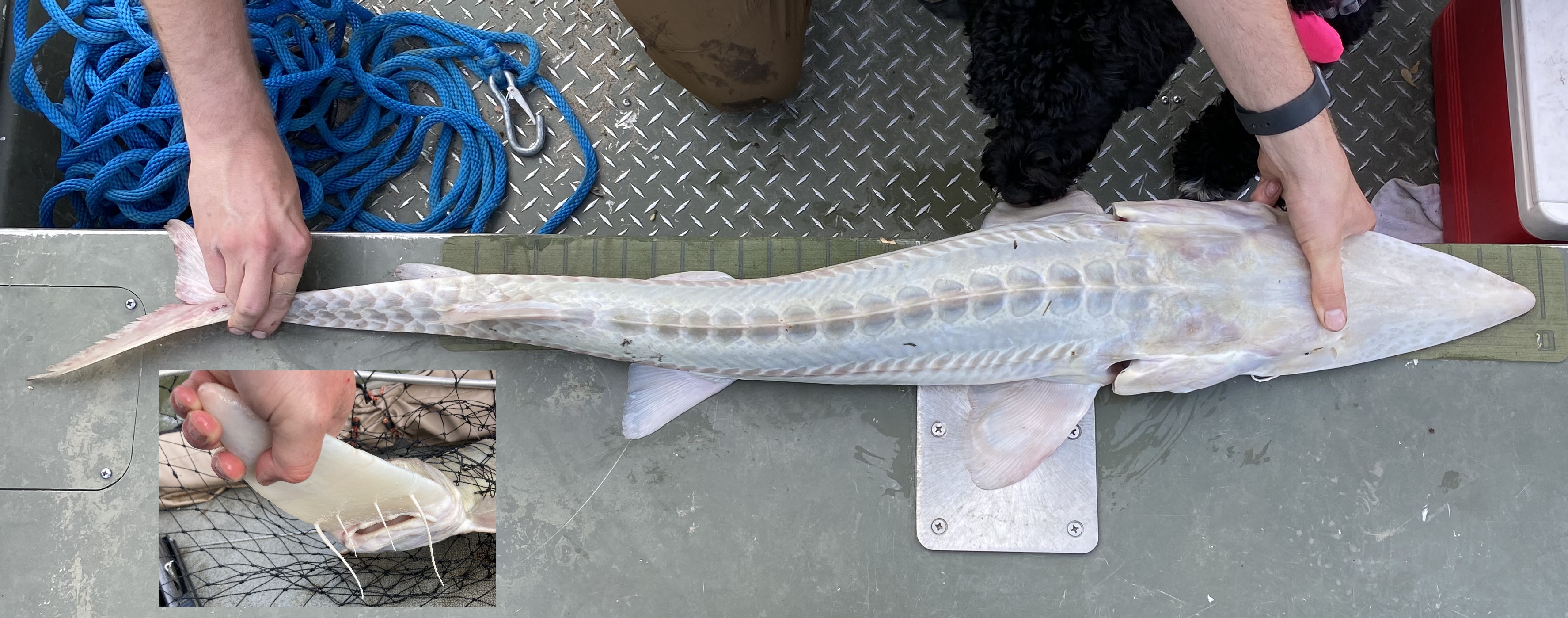Fish Iowa - Fish Species - Pallid Sturgeon

Characteristics
The Pallid Sturgeon Scaphirhynchus albus is a long-lived, bottom-dwelling fish native to large river systems of the central United States. It closely resembles the more common Shovelnose Sturgeon Scaphirhynchus platorynchus but is distinguishable by its pale, grayish-white coloration, longer and more sharply pointed snout, and smaller eyes. A key diagnostic feature is its barbels: the two inner barbels on the underside of its snout are significantly shorter than the outer pair, forming a crescent-like arrangement. In contrast, Shovelnose Sturgeon have four barbels of roughly equal length arranged in a straight line. Additionally, the Pallid Sturgeon has a smooth, scaleless (naked) belly, while the Shovelnose's belly is covered with rough, plate-like scutes. Pallid Sturgeon grow much larger than Shovelnose Sturgeon. Individuals over 37 inches are likely either Pallid or Lake Sturgeon. Maximum reported lengths exceed 5 feet, and weights can reach 60–70 pounds, although such sizes are rare.
Foods
Pallid Sturgeon are opportunistic bottom feeders. They use their sensitive barbels to locate prey along the riverbed and vacuum food into their protrusible, toothless mouths. Their diet includes aquatic insect larvae (especially midges and mayflies), small fish, snails, crustaceans, and organic detritus. Foraging activity is typically concentrated in areas with moderate to strong current and soft substrates.
Expert Tip
- No results found
Details
The Pallid Sturgeon is one of the most endangered species in North America. Pallid Sturgeon were formally recognized as a distinct species in 1905, having previously been grouped with the Shovelnose Sturgeon. It was listed as federally endangered in 1990 due to significant population declines and a near absence of natural reproduction in much of its range.
Until recently, its presence in Iowa was known only from a single specimen collected near Keokuk in 1930 and the Iowa section of the Missouri River. However, in spring 2025, Iowa DNR biologists captured two wild Pallid Sturgeon from the lower Des Moines River, marking the first documented occurrence in that waterway. Genetic testing confirmed that these individuals were of wild, non-hatchery origin. This historic finding suggests a previously undocumented natural expansion into the Des Moines River and highlights the river’s potential as viable habitat for this imperiled species.
Despite this discovery, the Pallid Sturgeon remains extremely rare throughout its range. Most individuals encountered in nearby river systems, particularly the Missouri River, originate from hatchery stocking programs. Recovery of the species remains a long-term challenge due to its late maturity, low natural recruitment, and degraded river habitats.
Habitat and Life History
Pallid Sturgeon are adapted to large, turbid, free-flowing rivers with deep channels, strong currents, and sandy or gravelly substrates. Historically, they occupied much of the Missouri and lower Mississippi River basins. Their range has dramatically diminished over the last century due to widespread river modification, but they are still found in isolated stretches of these systems.
Spawning occurs in late spring or early summer and is cued by rising water temperatures and increased river discharge. Males typically mature between 5 and 7 years of age, while females may not reach reproductive maturity until 15 to 20 years. Females spawn only every few years. Larvae drift downstream shortly after hatching and depend on suitable flows and channel structure to survive and settle into lotic nursery habitats.
In northern portions of their range, such as the upper Missouri and Yellowstone River basin, growth is relatively slow. For example, Pallid Sturgeon in South Dakota may reach about 23 inches in length by age five. Individuals can live for 40 years or more.
Distribution Map

Fishing is not allowed for this species.
If you catch this species, immediately return it to the water with as little injury as possible.